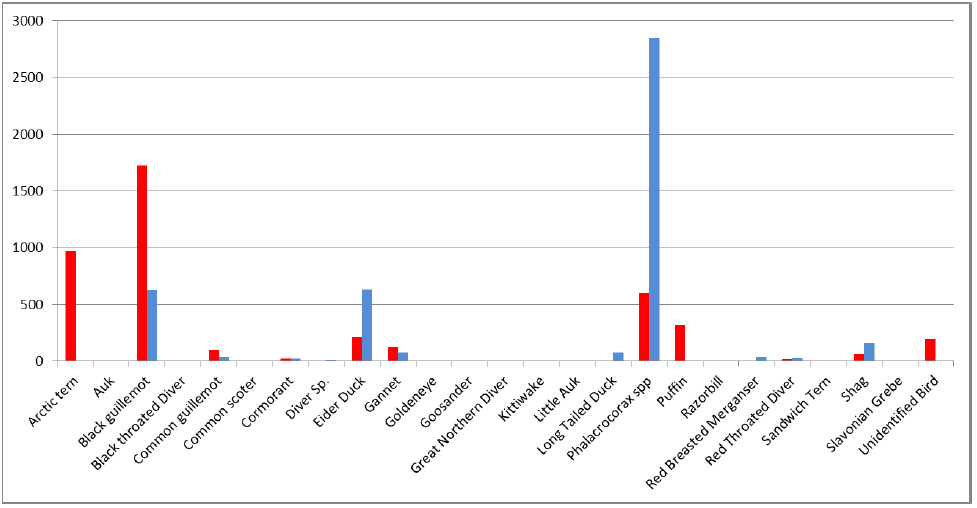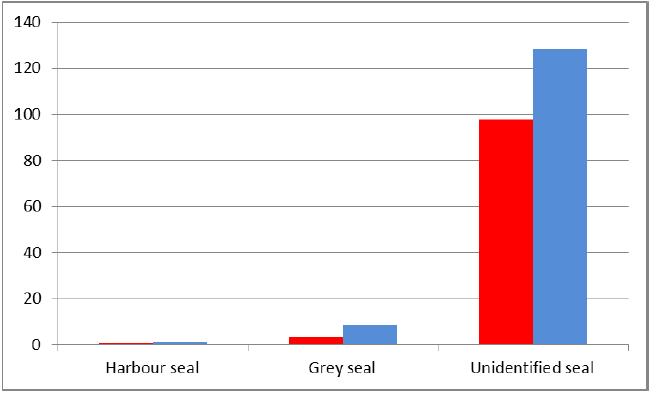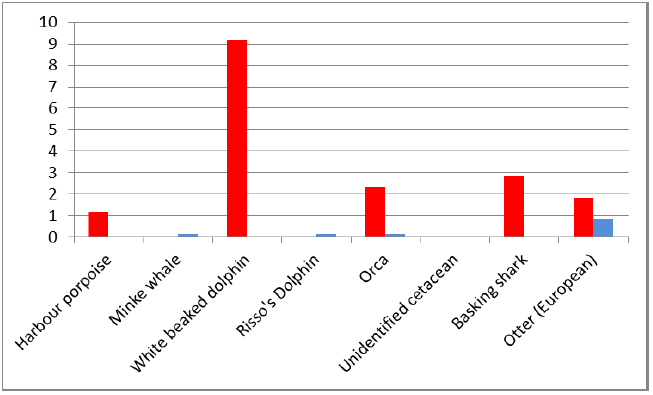Scottish Marine and Freshwater Science Volume 5 Number 7: EMEC Fall of Warness Tidal Test Site: Wildlife Observations Project Annual Report
Annual report of the wildlife observation programme underway at the European Marine Energy Centre (EMEC) in Orkney - Fall of Warness
4. Project Summary
4.1 Site Activity
A number of developers have completed various stages of device installation at the test site during the period 1 April 2013 to 31 March 2014. Table 1 below summarises work in progress during this period.
| EMEC Berth | Developer | Activity |
|---|---|---|
| 1 | Hammerfest Strom UK | Device testing |
| 2 | Tidal Generation Ltd. | Device testing |
| 3 | Kawasaki Heavy Industries | No activity |
| 4 | Open Hydro | Device testing |
| 5 | Bluewater | No activity |
| 6 | Atlantis | No activity |
| 7 | Voith Hydro | Device nacelle installed Sept. 2013 |
| 8 | Scotrenewables | Device testing |
Table 1: Developer site activity at the EMEC Fall of Warness test site 1st April 2013 to 31st March 2014
Installed devices may or may not be operational at any given time. Typical additional activity at the test site may include periodic complete removal/re-installation of devices for maintenance, maintenance visits by developers, deployment of Acoustic Doppler Current Profilers to measure tidal resource, and acoustic surveys.
4.2 Project Activity
Overall, this contract period has seen a very high completion rate of planned watches, with an average watch achievement rate of 95%.
The third quarter of the contract suffered a reduced rate of data collection due to the exceptionally heavy storms which were a persistent feature of the UK and Orkney weather pattern in winter 2013/14. The reduced daylight hours experienced in Orkney during the winter months afford less flexibility in the schedule. Nevertheless, watch achievement rates remained above 80% for all months, with the exception of May which was affected by observers' holidays (see Table 2 below).
| Month | Percentage (%) | Actual/Potential Hours | Comments |
|---|---|---|---|
| April 2013 | 100 | 80/80 | |
| May 2013 | 65 | 52/80 | Annual holiday |
| June 2013 | 100 | 80/80 | |
| July 2013 | 100 | 80/80 | |
| August 2013 | 100 | 80/80 | |
| September 2013 | 100 | 80/80 | |
| October 2013 | 100 | 80/80 | |
| November 2013 | 90 | 72/80 | Bad weather |
| December 2013 | 88 | 70/80 | Bad weather |
| January 2014 | 98 | 78/80 | Bad weather |
| February 2014 | 96 | 77/80 | Bad weather |
| March 2014 | 100 | 80/80 |
Table 2: Achievement of watches expressed as a percentage and actual contractual hours per month.
A new observer joined the observation team in November 2013, to replace one who resigned. As with previous changes to the team, the lead wildlife observer trained the new observer in the methodology and characteristics of the observation area through a series of shadowed watches, culminating in a set of dual watches carried out on the 4 th and 5 th November 2013. There was a high level of correlation in the results of these dual watches as can be seen from Table 3 and Table 4 below. The apparent discrepancy in numbers recorded for shag and phalacrocorax species ( Table 4) is due to the time taken for detailed identification, and the variance observed when the total number of these species is taken together with the number of cormorant is only 5.
| Number of Species Recorded | ||
|---|---|---|
| Lead | New | |
| GANNET | 19 | 17 |
| PHALACROCORAX | 98 | 106 |
| EIDER | 3 | 1 |
| Total | 120 | 124 |
Table 3: Analysis of results of dual watch carried out on 04/11/2013
| Number of Species Recorded | ||
|---|---|---|
| Lead | New | |
| PHALACROCORAX | 51 | 157 |
| SHAG | 108 | 8 |
| CORMORANT | 1 | 0 |
| SEAL | 11 | 17 |
| RED THROATED DIVER | 7 | 7 |
| BLACK GUILLIEMOT | 34 | 22 |
| EIDER | 38 | 42 |
| GREAT NORTHERN DIVER | 1 | 1 |
| RED BREASTED MERGANSER | 5 | 7 |
| GANNET | 2 | 2 |
| Total | 258 | 263 |
Table 4: Analysis of results of dual watch carried out 05/11/2013
In order to ensure consistency in the data collected, the lead wildlife observer continues to supervise and collate the results from all observers in the team.
4.3 Wildlife Observations Summary
Detailed analysis of the data collected is out-with the scope of this project. The entire set of raw wildlife observation data collected for the period 1 April 2013 to 31 March 2014 is available to download from the Marine Scotland Interactive website.
The monthly wildlife sighting counts are presented in Table 5 and Table 6 below. Note these sightings are total sightings per month, and have not been corrected for effort (number of hours observed per month). Seasonal graphs showing sighting counts per mean summer month and per mean winter month are also provided ( Figures 2 to 4).
A high proportion of seals sighted are recorded as 'unidentified'. This is mainly due to a combination of environmental conditions (light, glare, sea state, etc) and distance from the observation point making it difficult to identify seals to species level. Also, it is very difficult to distinguish young grey seals (up to around 3 months old) from adult harbour seals when in the water.
Monthly wildlife sighting counts with respect to monthly means (calculated from the entire EMEC Wildlife Observations Programmes Fall of Warness dataset) are presented graphically as Annex B.
| Species | Apr-13 | May-13 | Jun-13 | Jul-13 | Aug-13 | Sep-13 | Oct-13 | Nov-13 | Dec-13 | Jan-14 | Feb-14 | Mar-14 |
|---|---|---|---|---|---|---|---|---|---|---|---|---|
| Arctic tern | 0 | 373 | 4508 | 880 | 36 | 0 | 0 | 0 | 0 | 0 | 0 | 0 |
| Auk | 0 | 0 | 0 | 0 | 0 | 0 | 0 | 0 | 0 | 0 | 0 | 0 |
| Black guillemot | 3564 | 1542 | 2103 | 2077 | 1015 | 29 | 35 | 66 | 64 | 235 | 1343 | 1990 |
| Black throated Diver | 0 | 0 | 0 | 0 | 0 | 0 | 0 | 0 | 0 | 0 | 0 | 0 |
| Common guillemot | 82 | 69 | 319 | 114 | 1 | 8 | 16 | 0 | 3 | 33 | 128 | 57 |
| Common scoter | 0 | 0 | 0 | 0 | 0 | 0 | 0 | 0 | 0 | 0 | 0 | 0 |
| Cormorant | 11 | 16 | 46 | 11 | 42 | 8 | 28 | 24 | 24 | 32 | 13 | 45 |
| Diver Sp. | 4 | 0 | 3 | 0 | 0 | 0 | 0 | 15 | 22 | 6 | 26 | 11 |
| Eider Duck | 986 | 163 | 64 | 39 | 4 | 3 | 147 | 501 | 772 | 446 | 905 | 1012 |
| Gannet | 10 | 13 | 26 | 149 | 357 | 199 | 147 | 210 | 110 | 7 | 0 | 4 |
| Goldeneye | 0 | 0 | 0 | 0 | 0 | 0 | 0 | 0 | 0 | 0 | 0 | 0 |
| Goosander | 0 | 0 | 0 | 0 | 0 | 0 | 0 | 0 | 0 | 0 | 0 | 0 |
| Great Northern Diver | 0 | 0 | 27 | 0 | 0 | 0 | 1 | 7 | 12 | 8 | 13 | 8 |
| Kittiwake | 0 | 0 | 0 | 26 | 0 | 0 | 0 | 0 | 0 | 0 | 0 | 0 |
| Little Auk | 0 | 0 | 0 | 0 | 0 | 0 | 0 | 0 | 0 | 1 | 0 | 0 |
| Long Tailed Duck | 0 | 0 | 0 | 0 | 0 | 0 | 0 | 29 | 97 | 103 | 147 | 71 |
| Phalacrocorax Sp. | 914 | 241 | 279 | 339 | 474 | 1359 | 2285 | 4740 | 6124 | 1473 | 1526 | 926 |
| Puffin | 249 | 120 | 803 | 695 | 68 | 0 | 0 | 0 | 0 | 0 | 1 | 22 |
| Razorbill | 3 | 1 | 17 | 1 | 0 | 0 | 0 | 0 | 0 | 0 | 4 | 3 |
| Red Breasted Merganser | 37 | 0 | 0 | 6 | 0 | 6 | 51 | 52 | 40 | 29 | 34 | 25 |
| Red Throated Diver | 23 | 13 | 4 | 3 | 7 | 73 | 94 | 36 | 18 | 14 | 19 | 18 |
| Sandwich Tern | 1 | 0 | 0 | 0 | 0 | 0 | 0 | 0 | 0 | 0 | 0 | 0 |
| Shag | 73 | 67 | 71 | 78 | 59 | 40 | 109 | 292 | 159 | 135 | 102 | 181 |
| Slavonian Grebe | 0 | 0 | 0 | 0 | 0 | 0 | 0 | 0 | 0 | 0 | 0 | 0 |
| Unidentified Bird | 60 | 33 | 235 | 743 | 87 | 5 | 3 | 1 | 1 | 0 | 3 | 7 |
| Total Birds | 6017 | 2651 | 8505 | 5161 | 2150 | 1730 | 2916 | 5973 | 7446 | 2522 | 4264 | 4380 |
Table 5: Monthly sighting counts for bird species for period April 2013 to March 2014 at the EMEC Fall of Warness tidal test site.
| Species | Apr-13 | May-13 | Jun-13 | Jul-13 | Aug-13 | Sep-13 | Oct-13 | Nov-13 | Dec-13 | Jan-14 | Feb-14 | Mar-14 |
|---|---|---|---|---|---|---|---|---|---|---|---|---|
| Harbour seal | 0 | 0 | 1 | 1 | 3 | 0 | 3 | 0 | 0 | 0 | 0 | 3 |
| Grey seal | 0 | 0 | 1 | 1 | 4 | 14 | 21 | 10 | 7 | 12 | 1 | 0 |
| Unidentified seal | 105 | 27 | 70 | 90 | 72 | 224 | 521 | 73 | 50 | 50 | 65 | 11 |
| TOTAL SEALS | 105 | 27 | 72 | 92 | 79 | 238 | 545 | 83 | 57 | 62 | 66 | 14 |
| Harbour porpoise | 5 | 0 | 0 | 0 | 2 | 0 | 0 | 0 | 0 | 0 | 0 | 0 |
| Minke whale | 0 | 0 | 0 | 0 | 0 | 0 | 0 | 0 | 1 | 0 | 0 | 0 |
| White beaked dolphin | 0 | 0 | 0 | 55 | 0 | 0 | 0 | 0 | 0 | 0 | 0 | 0 |
| Risso's dolphin | 0 | 0 | 0 | 0 | 0 | 0 | 0 | 1 | 0 | 0 | 0 | 0 |
| Orca | 8 | 0 | 0 | 6 | 0 | 0 | 0 | 1 | 0 | 0 | 0 | 0 |
| Unidentified cetacean | 0 | 0 | 0 | 0 | 0 | 0 | 0 | 0 | 0 | 0 | 0 | 0 |
| TOTAL CETACEANS | 13 | 0 | 0 | 61 | 2 | 0 | 0 | 2 | 1 | 0 | 0 | 0 |
| Basking shark | 0 | 1 | 0 | 0 | 5 | 11 | 0 | 0 | 0 | 0 | 0 | 0 |
| Otter (Euoropean) | 6 | 1 | 2 | 0 | 1 | 1 | 1 | 1 | 2 | 1 | 0 | 0 |
Table 6: Monthly sighting counts for seals, cetaceans and other species for period April 2013 to March 2014 at the EMEC Fall of Warness tidal test site.
Figures 2 to 4 below summarise the species of birds, cetaceans and seals observed at the Fall of Warness tidal test site during summer (April to September) and winter (October to March) months. Values shown are mean summer month (red) and mean winter month (blue). Any inter-seasonal comparisons drawn from Figures 2 to 4 should be made with caution as the data represents only one year of observations.

Figure 2: Mean summer month (red) and mean winter month (blue) bird species sightings at the Fall of Warness for period April 2013 to March 2014.

Figure 3: Mean summer month (red) and mean winter month (blue) seal species sightings at the Fall of Warness for period April 2013 to March 2014.

Figure 4: Mean summer month (red) and mean winter month (blue) cetacean, basking shark and otter species sightings at the Fall of Warness for period April 2013 to March 2014.
4.4 Issues & Concerns
Under a separate project funded by Marine Scotland and SNH, EMEC will undertake detailed analysis of the data gathered through this project. Within the data analysis project, EMEC has sought expert input from the Centre for Research into Ecological and Environmental Modelling ( CREEM) who have identified a limitation with the data in that there is insufficient data to construct 'detection functions' for the test sites.
To address this limitation, EMEC has developed a proposal for funding a boat-based calibration exercise to collect additional wildlife observation data at the test sites. This would provide information about the detectability rates for a range of distances from the observation points. The steering group for the data analysis project (which comprises Marine Scotland, SNH and EMEC) agree that the construction of site-specific detection functions, which will enable modelling of absolute changes in surface-visible wildlife presence, is an important output of the analysis project.
Contact
There is a problem
Thanks for your feedback